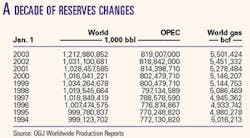Worldwide oil and gas reserves estimates have surged from a year ago. This is due to revisions and new data related to many countries' reserves figures. The biggest change is in the oil reserves figure now listed for Canada. This one change has drastically altered the percentage of oil reserves attributed to OPEC countries.
Based on Oil & Gas Journal estimates and data gathered from an annual survey of government agencies and companies, total worldwide proved crude oil and condensate reserves as of Jan. 1, 2003, are 1.2 trillion bbl. Natural gas reserves are estimated at 5.5 quadrillion cu ft, up slightly from a year ago.
OGJ estimates that 2002 worldwide production of crude and condensate was little changed from last year and has held relatively steady for the past 3 years.
Changes
The reserves figures published here are based on survey responses and updates released by individual countries, which in many cases are not released every year—if ever. OGJ changes a particular reserves figure only when it receives not only evidence that a change is necessary but also a reliable, new estimate.
The jump in reserves for Canada reflects the inclusion of Alberta's oil sands. Conventional crude oil and condensate reserves, as reported by Canadian Association of Petroleum Producers (CAPP), stand at 5.2 billion bbl. An additional 174.8 billion bbl of bitumen is contained in the oil sands, reports Alberta's Energy & Utilities Board. CAPP considers this estimate to accurately represent the volume of crude bitumen that is recoverable using current technology.
This single change diminishes OPEC's share of the world's oil reserves by more than 10 percentage points. The organization is now attributed with 67.5% of all crude and condensate reserves, down from the previous estimate of 79.4%. OPEC also controls 45% of the world's natural gas reserves, down slightly from previous estimates.
New data that OGJ received from Egypt, Ecuador, New Zealand, and Spain also resulted in big changes to those countries' published oil and gas reserves. Colombia, Pakistan, and Poland reported new estimates that reflect discoveries in those countries, and new figures for Greece and India are the result of reevaluations of their reserves.
Large increases were made to estimates for the former Soviet Union. The lack of good sources of data for reserves in Azerbaijan, Kazakhstan, and Russia results in conservative estimates, however.
To comply with US Securities and Exchange Commission filing guidelines, Petroleos Mexicanos in September revised downward its oil and gas reserves figures. Proved oil reserves in Mexico now total 12.6 billion bbl, whereas a year ago they were reported at 26.9 billion bbl, and gas reserves are 8.8 tcf, revised from an estimated 29.5 tcf.
US reserves
EIA's most recent figures show an increase in US reserves during 2001, replacing production by substantial margins. Reserves additions exceeded production by 21% for oil and 31% for natural gas.
Oil reserves are up 1.8% from a year earlier, while gas reserves increased 3.4%. Thunder Horse, expected to be the largest field in the Gulf of Mexico, accounts for much of the addition to oil reserves. Deepwater crude oil reserves are now almost three times those in the shallower water of the continental shelf. Total discoveries of crude oil were 2.565 billion bbl, almost twice the year-earlier discoveries, according to EIA, and new field discoveries account for nearly half of that.
US gas reserves have increased in 7 of the last 8 years. The majority of the most recent proved gas reserves additions were in Pinedale field in Wyoming, Lobo trend and Barnett shale fields in Texas, and Wattenberg field in Colorado, and most of them required the application of improved technology, EIA reported.
Coalbed methane now accounts for 9.6% of proved gas reserves, with reserves added in Colorado and in the Powder River basin of Wyoming.
Production
OGJ estimates that worldwide production of crude and condensate declined this year to 66 million b/d, down from 66.7 million b/d. Actual production in 2000 was 67.2 million b/d.
OPEC oil production is estimated to have declined 7% from last year following a pledge to cut output 1.5 million b/d effective Jan. 1, 2002. The organization implemented no other output change agreements this year.
On the strength of Russian output growth, total oil production in Eastern Europe and the former Soviet Union increased 8.5% this year, while Western European production declined 2%.
Total output in the Western Hemisphere, Africa, and the Asia-Pacific region was nearly unchanged from 2001. Middle East crude and condensate production declined 6.4%.
Click here to view pdf Worldwide Look At Reserves and Production



